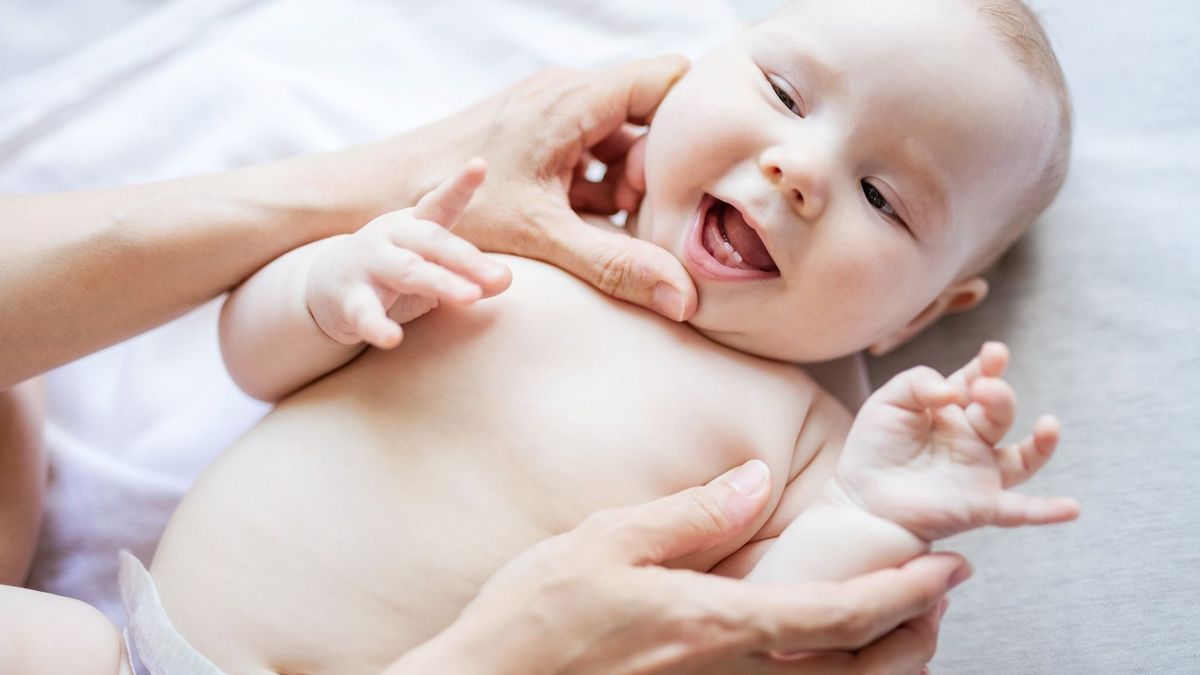
You may have noticed white bumps appearing in your baby’s mouth at the gum line. Is this your child’s first teething already? Or is it something else related to teething? How to relieve your baby if he has pain? We take stock with Dr. Pauline Feraud, pedodontist.
During his first months, your baby’s health is under scrutiny. And children’s mouths can be scrutinized, especially their gums. Indeed, white tips can appear. Explanations…
What are white tips on babies’ gums?
“The white tips that can be seen in infants are what are known as Epstein pearls. These are completely benign cysts that will disappear with suction (feeding bottle or feeding with milk) and with the growth of milk teeth (deciduous teeth). These small cysts can remain from birth until the appearance of the first milk teeth. But in general, these pearls disappear in 1 month, approximately. No treatment is necessary”explains Pauline Feraud, pedodontist, before adding: “Some white tips can also be teeth… this is called the neonatal tooth. It looks like milk teeth but the root construction has not necessarily ended”.
Beware, Epstein pearls are not to be confused with eruption cysts before teething: these cysts take the form of small balls of bluish color, at the level of the gum. They will drain on their own when the tooth erupts. Also in this case there is no medical treatment.
Young parents, be reassured, it is not necessarily necessary to consult a pediatrician or pedodontist at this stage for your child’s teeth. On the other hand, in case of doubt, a visit may be recommended, especially if it is not possible to know whether it is an Epstein pearl or a neonatal tooth.
The good health reflexes to have if teeth appear
“If the teeth move, be careful, it is better to have them removed to avoid the risk of going the wrong way”advises our expert.
If they do not move, it is better to leave them in place, unless they interfere too much with feeding (in the event of breastfeeding, for example). If in doubt, do not hesitate to consult a health professional (paediatrician, general practitioner, dentist, pedodontist, etc.).
Know that in general, behind a neonatal tooth, there is no milk tooth.
What about teething?
The symptoms of teething in children result in conditions in the ENT sphere (angina / otitis / rhinitis):
- Red cheeks ;
- Swollen gums;
- Fever/pain;
- Abundant salivation.
All of which can cause in the infant: loss of appetite, sleep disturbance, restlessness, irritability… Again, don’t worry, it’s normal!
Relieve baby toothache
There are several possibilities to relieve the pain associated with the first teething.
Applications directly to the gums of infants
This can take the form of gingival anesthetic gels or even cold to put on the gum. Do not hesitate to offer your baby a teething ring/comforter… According to Pauline Feraud, “the teething ring by itself does not relieve pain. It is the biting that relieves. So any object can relieve it… On the other hand, their shape must be well adapted so as not to hurt the infant”.
It is also possible to massage the gums directly after a good disinfection of the hands of the parents.
Drug treatment
To relieve pain and or in case of fever, taking paracetamol adapted to the weight of the child, every 6 hours, is possible.
A homeopathic treatment
In addition, it is also possible to use homeopathy to relieve your baby. Ask your pediatrician, pharmacist or healthcare professional for advice. “Only downside: the amber necklaces... although our grandmothers are in favor of it, no scientific proof has been provided and there is a risk of strangulation. They are therefore to be avoided.advises Dr. Pauline Feraud.
The order of appearance of milk teeth
It is specific to each child but in general, the milk teeth follow this chronology:
- The lower incisors (the 4) (6-10 months);
- The upper incisors (the 4) (7-12 months);
- The first upper molar (12-24 months);
- Lower first molar (12-24 months);
- The canines (15-24 months);
- The second molar (between 2 and 3 years old).
There are no premolars for baby teeth.
“The milk molars will be replaced later by our premolars and the permanent molars do not replace any milk teeth”assures the pedodontist.
Take care of baby’s mouth
All dentists will tell you: babies’ oral hygiene is important from the first months. It contributes to health and good development.
Tooth brushing with suitable equipment
For Dr. Feraud, “as soon as the first teeth appear, they must be brushed with a specialized toothbrush, a finger cot or even compresses with water. Personally, I recommend toothpaste from the age of two. But, more and more toothpastes are adapted to the first baby teeth. It is very important to try to stop night feeding at the age of 6 months in order to limit the risk of caries early childhood on milk teeth or bottle tooth decay”.
Choosing the right fluoridated toothpaste
Fluoride is necessary for the proper mineralization of teeth in children. Without it, the teeth are not mineralized enough, the enamel is therefore more flexible and is more likely to decay… On the other hand, it is necessary to respect the fluoride levels according to the age of the child. and not giving adult toothpaste, for example.
Here is the fluoride level according to the USFBD (French Union for Oral Health):
- 2-6 years: 1000 ppm (start at a trace amount of toothpaste on the toothbrush, then gradually increase);
- 6 years and over: 1450 ppm.
Advice from our expert:For high caries risks, the dosages may be different, but you must consult a pedodontist so that he can tell you which toothpaste to use for your child. Finally, a tooth brushing morning and evening is recommended“.
